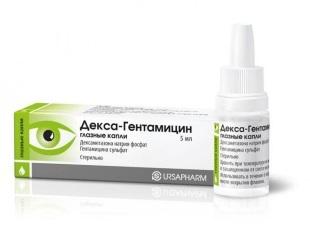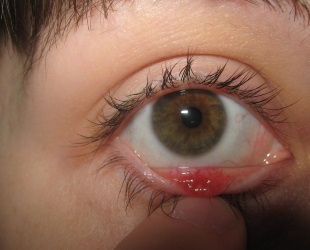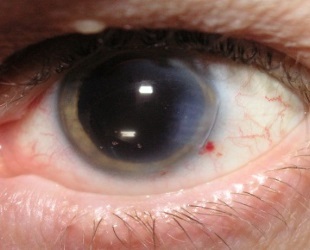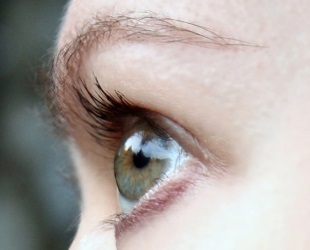
In the treatment of inflammatory diseases of the eye and eyelids, it is important not only to cope with the cause of their occurrence.
It is also necessary to relieve painful symptoms: lacrimation, swelling, burning and itching.
Therefore, many modern drugs combine several active substances.
These include Dexa-Gentamicin - eye drops and ointment, which have both anti-inflammatory and antimicrobial effect.
Instruction for use
- 1. Instructions for use
- 2. Side effects of
- 3. Conditions and shelf life of
- 4. Cost of
- 5. Analogues of
- 6. Reviews of Dexa Gentamycin
- 7. What aboutcan we say in conclusion?
- 8. Video
Indications for use
Drops Dexa-Gentamicin are effective in the following diseases:
- barley, blepharitis, conjunctivitis and other lesions of the anterior segment of the eye sensitive to the active component by microorganisms;
- is an allergic inflammation, especially complicated by a secondary infection.
They are also used after surgical treatment of eye diseases, such as cataracts, glaucoma and other surgically demanding diseases.
In this case, the drug is prescribed to prevent complications and to remove frequent inflammatory processes in the postoperative period.
Form and Composition
The preparation is a transparent colorless eye drop, poured over plastic bottles-droppers with a capacity of 5 ml. The composition of the drops includes two active components:
- gentamycin sulfate( 5 mg solution, which corresponds to the concentration of gentamicin in 3 mg);
- dexamethasone sodium phosphate( 1 mgmL).

Gentamicin is effective against gram-negative aerobic bacteria and many gram-positive cocci antibiotic.
Enough wide range of action makes it effective in most cases of inflammatory eye diseases.
Dexamethasone is a drug from the group of glucocorticosteroids, which has anti-inflammatory and anti-allergic effect.
Together they provide a fight both with the cause and with manifestations of the disease.
The composition of Dex-Gentamycin also includes auxiliary components, such as sodium chloride, potassium dihydrogen phosphate, dicalcium hydrogenphosphate, distilled water as a filler and benzazeconium chloride as a preservative.
The drug is prescription-dispensed.
How to use
With the help of a dropper, the drug is instilled in the conjunctival sac. One drop is enough for one eye. The procedure is repeated 4-6 times a day.
The course of treatment, depending on the disease and response to therapy, is usually not more than two weeks. Like other antibiotic-containing drugs, Dexa-Gentamicin is not recommended for long periods of time to avoid the development of resistance in the causative agent of the disease.
Interaction with other
drugs The simultaneous use of Dex-Gentamicin and atropine, as well as other cholinergic drugs, leads to an increase in intraocular pressure.
With the combined use of Dex-Gentamycin with sulfadiazine, cloxacillin, amphotericin B, heparin and cephalothin, there is a possibility of precipitates formation in the conjunctival sac.
Side effects of
The list of side effects of these eye drops is large enough, and the consequences, which occasionally leads to their use, are sometimes very serious.
It is important to remember that dexamethasone has not only anti-inflammatory and antiallergic effects, but also suppresses immunity, making the eye more vulnerable to viruses and fungi.
In the treatment of Dex-Gentamicin, the following complications are possible:
- allergic reactions of various types;
- increased intraocular pressure;
- dendritic keratitis;
- perforated corneal ulcer;
- fungal lesions of the eye and mucous lids( most often candidiasis);
- ptosis of the eyelids;
- mydriasis;
- is an inflammation of the auditory nerve.
Prolonged use, significantly exceeding the recommended time, may lead to the development of steroid glaucoma, as well as irreversible clouding of the lens.
Cases of overdose due to low concentrations of active ingredients and external use are not known.

Contraindications
Use of Dexa-Gentamycin will not only be useless, but also dangerous in many diseases, such as:
- viral lesions of the eye and its appendages( herpetic conjunctivitis, dendritic keratitis, severe chicken pox);
- tuberculosis of the eye;
- microbacterial and fungal eye diseases;
- corneal epitheliopathy;
- ulcers and corneal damage;
- other problems, accompanied by increased pressure inside the eye.

Also on the list of contraindications is the individual intolerance of the components that make up the drug, pregnancy during the first trimester and age to 18 years.
During the second and third trimesters of pregnancy and during lactation, Dexa-Gentamicin is administered with caution. During the course of treatment, contact lenses are not recommended.
In case of simultaneous application with other eye preparations, it is necessary to make a gap of 15-20 minutes between the introduction of different drugs into the conjunctival cavity.
Immediately after instillation, the drug can cause a short-term decrease in visual acuity, therefore within half an hour after its use it is worth to refrain from driving the car and performing another requiring more attention and quick reaction of work.
As mentioned above, the appearance of a number of contraindications may occur with the treatment of Dexa-Gentamicin. Negative effects can also occur when treated with other drops. Here are some articles on how to get rid of them:
- The first steps in the development of flies before the eyes
- What if there was a bleeding in the eye?
- Remove double vision in the eyes of
Storage terms and conditions
| Storage requirements | Must be stored in a cool, sheltered from the sun. Do not allow children and animals to enter this place. |
| Temperature | Less than 25 degrees Celsius above zero |
| Terms | Not more than 3 years in closed condition and less than 6 weeks in open |
The cost of

Dexa-Gentamycin is inexpensive: in Russian pharmacies it can be found for 120-150 rubles.
Residents of Ukraine will have to give a little more for the bottle of the drug, its average price in the territory of this state is 60-80 hryvnia.
Analogues of the preparation
The same scope and similar active substances in their composition have:
- Dexapoz;
- Garazon;
- Garamycin;
- Gentamicin K;
- Gentamicin Ferein;
- Gentamicin Akos.
Differ by composition, but also used for inflammatory eye diseases:
- Colbiocin ;
- Tetracycline;
- Levomycetin.
Some doctors recommend alternating different drugs for more effective destruction of the pathogen - this prevents microbes from forming resistance to a drug that has been used for a long time.
Reviews for Dexa-Gentamycin
As a positive side of the means, the people using it have noted the rapid removal of itching, irritation and other symptoms of the inflammatory process.
On the other hand, frequent allergic reactions and a large number of side effects caused many to refuse treatment with these drops.
Ineffectiveness in fungal, chlamydial and viral eye lesions is also a significant drawback, but a convenient drop-in packaging-dropper, on the contrary, liked very much.
What can we say in conclusion?
- Dexa-Gentamicin simultaneously removes the symptoms of inflammation and fights its cause.
- Effective for bacterial lesions of the eyes, but is useless against viruses and fungi.
- Has a large list of contraindications and side effects.
- It is used with caution during lactation, and in the last two trimester of pregnancy, in the first trimester is prohibited to consume.
- Costs inexpensively and is available even to the poorest patient.
In any case, before using it, you should weigh all the pros and cons and be sure to find out the exact diagnosis.
Video
We invite you to watch the following video:
